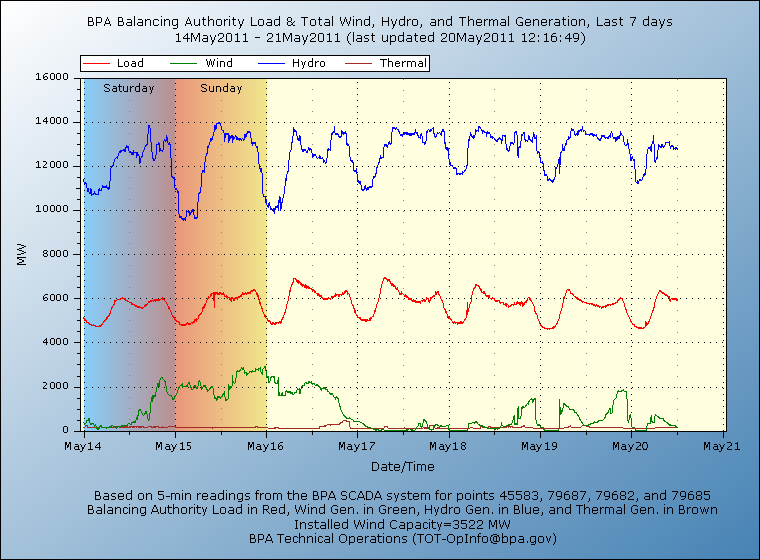forum
library
tutorial
contact

Northwest Power Provider
Limits Nonhydro Sources
by Joel MillmanWall Street Journal, May 18, 2011
|
the film forum library tutorial contact |

|
Northwest Power Provider
by Joel Millman |
 The largest Northwest snowpack since 1997 has left rivers swollen with run-off in Oregon, Idaho and Washington State and forced the Bonneville Power Administration to choose between two constituents: nonhydro-power generators and fish. On Wednesday the BPA chose the fish.
The largest Northwest snowpack since 1997 has left rivers swollen with run-off in Oregon, Idaho and Washington State and forced the Bonneville Power Administration to choose between two constituents: nonhydro-power generators and fish. On Wednesday the BPA chose the fish.
For the first time in its 74-year history, high river flows generating what the power provider called a "temporary oversupply" of hydropower led the BPA, based in Portland, Ore., to limit its output of nonhydroelectric energy--which includes fossil-fuel and thermal generation as well as wind energy.
The power transmitter first limited all coal and natural-gas generation to minimum levels required to keep its grid operating, then stopped receiving electricity from alternate sources.
BPA, a federal agency that supplies power to utilities in Washington, Oregon, Idaho and other Western states, announced it shut off other contributors to its grid last night shortly after midnight, when energy demand is at its lowest, and restored them shortly before dawn. BPA expects to continue turning other grid suppliers on and off this way through the end of spring, when snow melt-off ends.
BPA officials explained they have to limit the flow of water over dams along the Columbia River to protect salmon and steelhead trout, and so aren't able to simply send excess run-off through turbines without generating hydropower. And, since it is too soon for summer's heavy electricity use--and thousands of buildings' air conditioning units--the best alternative is cutting outside sources of power supply.
"Demand is so low, there was nowhere to put the power," said BPA spokesman Michael Milstein, who called pulling the plug on wind, thermal and fossil-fuel generators "the best of several bad options."
The BPA's decision is unprecedented, but not surprising. It was controversial. Opponents of the move said it was unfair to promote hydro power over wind, an alternative energy source favored by the Obama administration.
Last week, in anticipation of the BPA's move, the industry trade group, the American Wind Energy Association, warned that detaching wind farms from BPA's grid would cost producers in the Pacific Northwest millions in lost tax credits and frustrate entrepreneurs that must be assured of reliable demand for wind power before investing in wind technology.
U.S. Rep. Edward Markey (D., Mass.), a wind advocate, wrote to Energy Secretary Steven Chu last week trying to head off the BPA's decision. "This action, if implemented, would economically impact current facilities and could lead to the cancellation of future wind projects in the region," Mr. Markey warned.
Mr. Milstein, the BPA spokesman, conceded shortfalls estimated at between $10 million and $20 million that would result from lost tax credits if wind farms can't sell their power. "We recognize it's a real loss to them," he said.
Overgeneration Announcement related to graphic.To safeguard salmon and steelhead and assure reliable energy delivery during these unusually high seasonal river flows, BPA has taken the following measures, which it took as a last resort and had been working to avoid. BPA will update this site at 9 a.m. and 3 p.m., Monday through Friday.
[May 20, 9 a.m.] BPA temporarily limited the energy output of regional generators, including wind generators, from 11 p.m. May 19 until 5 a.m. May 20. During that six hour period, approximately 600 to 1,200 megawatts per hour of wind generation, totaling about 5,300 megawatt hours, were impacted.
[May 19, 3 p.m.] No current limits on generation
[May 19, 9 a.m.] BPA temporarily limited the energy output of regional generators, including wind generators, from 11 p.m. May 18 until 5 a.m. May 19. During that six hour period, slightly less than 1,000 megawatts per hour of wind generation, totaling about 5,700 megawatt hours, were impacted.
[May 18, 3 p.m.] No current limits on generation
[May 18, 9 a.m.] BPA temporarily limited the energy output of regional generators, including wind generators, from midnight until 5 a.m. May 18. Approximately 200-350 megawatts of wind generation per hour, totaling about 1,400 megawatt hours, were impacted.
learn more on topics covered in the film
see the video
read the script
learn the songs
discussion forum
